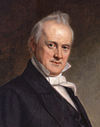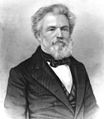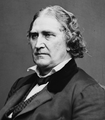1856 Democratic National Convention
| 1856 presidential election | |
  Nominees Buchanan and Breckinridge | |
| Convention | |
|---|---|
| Date(s) | June 2–6, 1856 |
| City | Cincinnati, Ohio |
| Venue | Smith and Nixon's Hall |
| Candidates | |
| Presidential nominee | James Buchanan of Pennsylvania |
| Vice-presidential nominee | John C. Breckinridge of Kentucky |
The 1856 Democratic National Convention was a presidential nominating convention that met from June 2 to June 6 in Cincinnati, Ohio. It was held to nominate the Democratic Party's candidates for president and vice president in the 1856 election. The convention selected former Secretary of State James Buchanan of Pennsylvania for president and former Representative John C. Breckinridge of Kentucky for vice president.
Incumbent Democratic President Franklin Pierce's standing with the public had been badly damaged by "Bleeding Kansas," the civil strife in Kansas Territory over slavery. Many dissatisfied Democrats lined up behind Buchanan, who had served as Pierce's ambassador to Britain and thus had avoided the controversy over Bleeding Kansas, while a smaller group of Democrats supported Senator Stephen A. Douglas of Illinois. Buchanan led on the first ballot and slowly grew his support on subsequent ballots, leading Pierce to instruct his delegates to back Douglas. Douglas agreed to withdraw his name after receiving assurances that Buchanan would not seek re-election in 1860, allowing Buchanan to clinch the nomination on the seventeenth ballot. Pierce became the first and only elected president who was an active candidate for reelection to be denied his party's nomination for a second term.
Eleven candidates received votes on the first vice presidential ballot, with Congressman John A. Quitman winning a plurality of the vote. The delegates lined up unanimously behind Breckinridge on the second ballot, giving him the vice presidential nomination. The Democratic ticket went on to win the 1856 election, defeating the Republican ticket of John C. Fremont and William L. Dayton and the American Party ticket of Millard Fillmore and Andrew J. Donelson.
Background
[edit]
|

|

|
| Senators James A. Bayard, Jesse D. Bright, and John Slidell (of Delaware, Indiana, and Louisiana respectively) helped to organize and orchestrate James Buchanan's eventual nomination in the convention. | ||
The Democratic Party was wounded from its devastating losses in the 1854–1855 midterm elections. The party faced continued north–south sectional division over slavery-related issues, especially the Kansas–Nebraska Act of 1854 and subsequent violence known as "Bleeding Kansas" from the civil strife in the Kansas Territory during its campaign for statehood. Two notable Democratic politicians, President Pierce and Senator Stephen Douglas of Illinois, were seen as being at the center of the controversies, which led many party members to look elsewhere for a new compromise candidate for president.
James Buchanan had been a candidate for president at the 1852 Democratic National Convention, and after the 1852 election he agreed to serve as Pierce's ambassador to Britain.[1] Buchanan's service abroad conveniently placed him outside of the country while the debate over the Kansas–Nebraska Act roiled the nation.[2] Powerful Senators like John Slidell, Jesse Bright, and James A. Bayard lined up behind Buchanan, presenting him as an experienced leader who could appeal to the North and South.[3] While Buchanan did not overtly seek the presidency, he also took no action to discourage his supporters.[4]
Proceedings
[edit]Called to order at noon on Monday, June 2, by the National Committee chair Robert Milligan McLane, Samuel Medary was made the temporary president. The first day, the convention appointed committees on credentials, organization, and resolutions.
On the second day the organization committee (John L. Dawson, chair) report was adopted and John Elliot Ward of Georgia was made the convention's president. The committee on credentials (James A. Bayard Jr., chair) settled a dispute over the Missouri delegation, but needed more time for the thorny problem of competing delegations from New York.
June 4 saw the adoption of a platform (former National Committee chair Benjamin F. Hallett headed the committee on resolutions); the domestic portions were supported unanimously, the foreign policy planks by large margins. A separately reported plank on a railroad to the Pacific coast failed by a vote of 120 to 154.
On June 5, the New York problem was finally settled by seating half of each of the competing delegations. Nominations for President were then made.
Presidential nomination
[edit]Presidential candidates
[edit]On the first ballot, Pierce received 122 votes, many of them from the South, to Buchanan's 135, with Douglas and Lewis Cass receiving the remaining votes. By the following morning fourteen ballots had been completed, but none of the three main candidates were able to get two-thirds of the vote. Pierce, whose support had been slowly declining as the ballots passed, directed his supporters to break for Douglas, withdrawing his name in a last-ditch effort to defeat Buchanan. Douglas, only 43 years of age, believed that he could be nominated in 1860 if he let the older Buchanan win this time, and received assurances from Buchanan's managers that this would be the case. After two more deadlocked ballots, Douglas's managers withdrew his name, leaving Buchanan as the clear winner. To soften the blow to Pierce, the convention issued a resolution of "unqualified approbation" in praise of his administration.[5] This loss marked the first (and until 2024, only) time in U.S. history that an elected president who was an active candidate for reelection was not nominated for a second term.[6]
| Presidential Ballot | |||||||||||||||||
|---|---|---|---|---|---|---|---|---|---|---|---|---|---|---|---|---|---|
| 1st | 2nd | 3rd | 4th | 5th | 6th | 7th | 8th | 9th | 10th | 11th | 12th | 13th | 14th | 15th | 16th | 17th | |
| Buchanan | 135.5 | 139 | 139.5 | 141.5 | 140 | 155 | 143.5 | 147.5 | 146 | 147.5 | 147.5 | 148 | 150 | 152.5 | 168.5 | 168 | 296 |
| Pierce | 122.5 | 119.5 | 119 | 119 | 119.5 | 107.5 | 89 | 87 | 87 | 80.5 | 80 | 79 | 77.5 | 75 | 3.5 | 0 | 0 |
| Douglas | 33 | 31.5 | 32 | 30 | 31 | 28 | 58 | 56 | 56 | 62.5 | 63 | 63.5 | 63 | 63 | 118.5 | 122 | 0 |
| Cass | 5 | 6 | 5.5 | 5.5 | 5.5 | 5.5 | 5.5 | 5.5 | 7 | 5.5 | 5.5 | 5.5 | 5.5 | 5.5 | 4.5 | 6 | 0 |
| Not Voting | 0 | 0 | 0 | 0 | 0 | 0 | 0 | 0 | 0 | 0 | 0 | 0 | 0 | 0 | 1 | 0 | 0 |
1st Day of Presidential Balloting / 4th Day of Convention (June 5, 1856)
-
1st Presidential Ballot
-
2nd Presidential Ballot
-
3rd Presidential Ballot
-
4th Presidential Ballot
-
5th Presidential Ballot
-
6th Presidential Ballot
-
7th Presidential Ballot
-
8th Presidential Ballot
-
9th Presidential Ballot
-
10th Presidential Ballot
-
11th Presidential Ballot
-
12th Presidential Ballot
-
13th Presidential Ballot
-
14th Presidential Ballot
2nd Day of Presidential Balloting / 5th Day of Convention (June 6, 1856)
-
15th Presidential Ballot
-
16th Presidential Ballot
-
17th Presidential Ballot
Vice Presidential nomination
[edit]Vice Presidential candidates
[edit]Declined
[edit]
Eleven candidates were nominated for the vice presidency, but a number of them attempted to withdraw themselves from consideration, among them the eventual nominee, John C. Breckinridge of Kentucky. Breckinridge supported fellow Kentuckian Linn Boyd for the vice presidential nomination. However, following a draft effort led by the delegation from Vermont, Breckinridge was nominated on the second ballot. As Vermont's David Allen Smalley stated, "No Democrat has a right to refuse his services when his country calls."
| Vice Presidential Ballot | |||
|---|---|---|---|
| 1st (Before Shifts) | 1st (After Shifts) | 2nd (After Shifts) | |
| Quitman | 60 | 59 | 0 |
| Breckinridge | 37 | 50 | 296 |
| Boyd | 33 | 33 | 0 |
| Bayard | 31 | 31 | 0 |
| Johnson | 31 | 31 | 0 |
| Brown | 29 | 29 | 0 |
| Butler | 27 | 27 | 0 |
| Dobbin | 15 | 13 | 0 |
| Rusk | 15 | 7 | 0 |
| Fitzpatrick | 13 | 11 | 0 |
| Polk | 5 | 5 | 0 |
-
1st Ballot
(Before Shifts) -
1st Ballot
(After Shifts) -
2nd Ballot
(After Shifts)
Aftermath
[edit]The Buchanan-Breckinridge ticket went on to win the 1856 presidential election, defeating John C. Fremont with William L. Dayton from the new Republican Party, and a strong third party showing from the American Party of the "Know Nothings" represented by former President Millard Fillmore and Andrew J. Donelson.
See also
[edit]- History of the United States Democratic Party
- 1856 Republican National Convention
- 1856 Whig National Convention
- List of Democratic National Conventions
- U.S. presidential nomination convention
- 1856 United States presidential election
References
[edit]- ^ Baker 2004, pp. 51–58.
- ^ Baker 2004, pp. 67–68.
- ^ Baker 2004, pp. 69–70.
- ^ Klein 1962, pp. 248–252.
- ^ Wallner (2007), pp. 266–70; Gara (1991), pp. 157–67, Holt (2010), loc. 1515–58.
- ^ Rudin, Ken (July 22, 2009). "When Has A President Been Denied His Party's Nomination?". NPR. Retrieved February 15, 2017.
Works cited
[edit]- Baker, Jean H. (2004). James Buchanan. Times Books. ISBN 0-8050-6946-1.
- Gara, Larry (1991). The Presidency of Franklin Pierce. University Press of Kansas. ISBN 0-7006-0494-4.
- Holt, Michael F. (2010). Franklin Pierce. The American Presidents (Kindle ed.). Henry Holt and Company, LLC. ISBN 978-0-8050-8719-2.
- Klein, Philip S. (1962). President James Buchanan: A Biography (1995 ed.). American Political Biography Press. ISBN 0-945707-11-8.
- Wallner, Peter A. (2007). Franklin Pierce: Martyr for the Union. Plaidswede. ISBN 978-0-9790784-2-2.
External links
[edit]- Democratic Party Platform of 1856 at The American Presidency Project
- Franklin Pierce at History.com
| Preceded by 1852 Baltimore, Maryland |
Democratic National Conventions | Succeeded by 1860 Baltimore, Maryland |



































